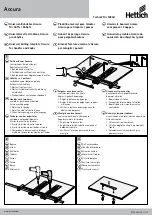
33
Parameter setting
Sensors Sewi KNX AQS and Sewi KNX AQS/TH-D
• Version: 10.09.2018 • Technical changes and errors excepted.
For an adequate regulation of the ambient temperature, comfort, standby, eco and
building protection modes may be used.
Comfort
when present,
Standby
during short absences,
Eco
as a night-time mode and
Frost/heat protection
(building protection) e. g. with the window open.
The settings for the temperature control include the setpoint temperatures for the in-
dividual modes. Objects are used to determine which mode is to be selected. A change
of mode may be triggered manually or automatically (e.g. by a timer, window contact).
The
mode
may be switched with two 8 bit objects of different priority. Objects
„... HVAC mode (Prio 2)“ for switching in everyday operation and
„... HVAC mode (Prio 1)“ for central switching with higher priority.
The objects are coded as follows:
0 = Auto
1 = Comfort
2 = Standby
3 = Eco
4 = Building Protection
Alternatively, you can use three objects, with one object switching between eco and
standby mode and the two others activating comfort mode and frost/heat protection
mode respectively. The comfort object blocks the eco/standby object, and the frost/
heat protection object has the highest priority. Objects
„... Mode (1: Eco, 0: Standby)“,
„... comfort activation mode" and
„... frost/heat protection activation mode"
Select the
mode to be activated after reset
(e.g. power failure, reset of the line via
the bus) (Default).
Then configure a temperature control
block
via the blocking object.
Specify when the current
control variables
of the controller are to be
sent
to the bus.
Periodic sending is safer, in case a message does not reach a recipient. You may also
set up periodical monitoring by the actuator with this setting.
Switch mode via
• two 8 Bit objects (HVAC Modes)
• three 1 bit objects
Mode after reset
• Comfort
• Standby
• Eco
• Building protection
Behaviour of the blocking object with value
• 1 = Block | 0 = release
• 0 = block | 1 = release
Value of the blocking object after reset
0 • 1
Send control variable
• on change
• on change and periodically
from change (in % absolute)
1...10; 2
















































